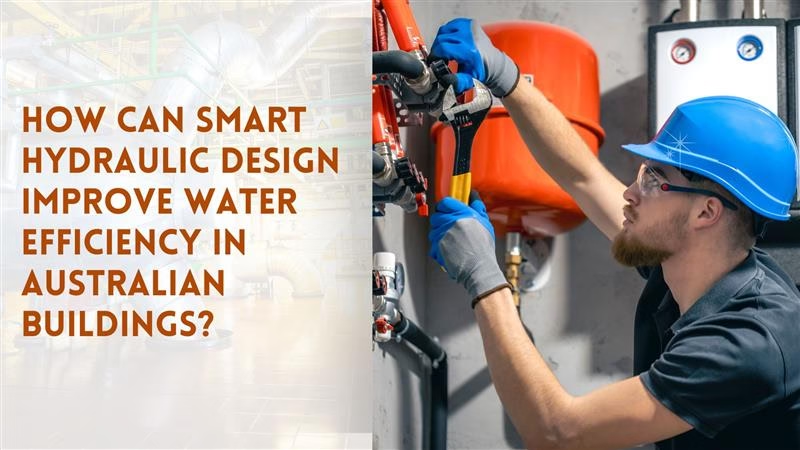How Can Smart Hydraulic Design Improve Water Efficiency in Australian Buildings?

Water is one of Australia’s most precious resources — and smart hydraulic engineering design plays a crucial role in conserving it. From rainwater harvesting to greywater recycling, modern hydraulic systems are helping reduce water use, lower operational costs, and boost sustainability ratings like Green Star and NABERS.
At Decobu, we design high-performance hydraulic systems tailored to Australia’s climate and regulatory needs. Here’s how innovative water strategies can be embedded into your building’s MEPF design — and why it matters.
What Is Hydraulic Engineering in Building Services?
In building services engineering, hydraulic systems refer to the design and management of water-related infrastructure:
- Potable water supply
- Wastewater and sewerage
- Stormwater and rainwater collection
- Greywater recycling
- Hot water systems and pressure boosting
- Backflow prevention and cross-contamination control
Hydraulic engineers ensure these systems operate safely, efficiently, and in compliance with codes like the National Construction Code (NCC) and local water authority requirements.
Why Is Water Efficiency So Important in Australia?
Australia faces increasing water scarcity due to climate change, drought, and urban growth. Buildings that actively reduce water consumption gain long-term advantages, including:
- Lower utility bills and operating costs
- Higher NABERS Water Ratings
- Green Star credits for sustainable design
- Easier compliance with Section J and local council guidelines
- Future-proofing against water restrictions and supply stress
What Are the Key Water-Saving Innovations in MEPF Hydraulic Design?
1. Rainwater Harvesting Systems
These systems collect and reuse rainwater for non-potable applications such as irrigation, toilet flushing, and cooling towers. They reduce mains water reliance and improve building resilience.
2. Greywater Recycling
Greywater from basins, showers, and laundry can be treated and reused within the building. It’s an excellent strategy in apartments, hotels, and large commercial buildings.
3. Water-Efficient Fixtures
Low-flow taps, dual-flush toilets, sensor-based systems, and waterless urinals help meet WELS standards and reduce everyday water usage without compromising performance.
4. Smart Monitoring and Sub-Metering
Digital flow meters and BMS integration allow facility managers to detect leaks, track usage patterns, and optimise performance over time — especially useful for NABERS tracking.
How Does Hydraulic Design Interact with Other Building Systems?
Water systems aren’t standalone. They’re part of an integrated MEPF design approach. For example:
- Stormwater harvesting must consider structural and civil coordination.
- Pump selections must align with electrical loads.
- Water-cooled HVAC systems rely on efficient plumbing integration.
- Backflow systems impact fire protection compliance.
A smart design process brings all disciplines together to create cost-effective, sustainable building solutions.
Interested in how sector-specific challenges shape this approach? See our blog on how Decobu delivers sector-specific MEPF design across Australia.
How Can Decobu Help with Sustainable Hydraulic Design?
At Decobu, we design hydraulic solutions that are both innovative and cost-effective. Our team:
- Integrates water-saving strategies from early planning stages
- Optimises systems for NABERS and Green Star performance
- Ensures seamless coordination with mechanical, electrical, and fire systems
- Provides detailed cost-planning and constructability advice tailored to each sector
Whether it’s a commercial office in Sydney or a regional healthcare project, our experience ensures compliance, performance, and sustainability.
FAQs
Q: Can rainwater be used for cooling towers in Australia?
Yes, but it must meet treatment standards and be approved by local authorities. It’s commonly done in commercial buildings aiming for water conservation.
Q: How much can greywater recycling save in a multi-residential project?
Up to 30–50% of mains water usage can be offset, depending on usage and occupancy.
Q: What building types benefit most from rainwater harvesting?
Warehouses, education facilities, and large commercial projects often have significant roof areas and non-potable demand, making them ideal for harvesting systems.
Final Thoughts
Hydraulic innovation is more than good plumbing — it’s a core part of sustainable building services. When integrated with smart, coordinated MEPF design, these water strategies help future-proof your project and unlock performance benefits across the board.
Looking to embed water-saving systems into your next project?
Contact Decobu for tailored hydraulic engineering solutions that deliver compliance, cost-efficiency, and sustainability.
Found Interesting? Share the insights
Related Posts

Why Early Hydraulic Engineering Services Matter for Australian Construction
Why Early Hydraulic Engineering Services Matter for Australian Construction Hydraulic systems sit at the core of every building — managing water supply, drainage, stormwater, gas,

Electrical Design Engineering: What Sydney Developers Need to Ask Before Starting
Electrical Design Engineering: What Sydney Developers Need to Ask Before Starting Electrical design plays a much bigger role in modern buildings than many developers realise.

3 Mechanical Design Mistakes That Cost Building Owners in Australia
3 Mechanical Design Mistakes That Cost Building Owners in Australia Mechanical design isn’t usually the first thing people think about when planning a building —

Why Do Brisbane Projects Need Expert Fire Engineering Consultants?
Why Do Brisbane Projects Need Expert Fire Engineering Consultants? Introduction Fire safety is one of the most vital aspects of any construction project — yet

Why Building Services Engineering Matters in Every Project in Sydney
Why Building Services Engineering Matters in Every Project in Sydney When it comes to modern construction, it’s easy to focus on architecture and aesthetics. Yet,

Why Hydraulic Engineering Services Are More Than Just Pipes and Pumps
Why Hydraulic Engineering Services Are More Than Just Pipes and Pumps Hydraulic engineering is often thought of as just plumbing — pipes, pumps, and water

